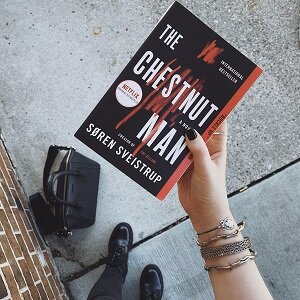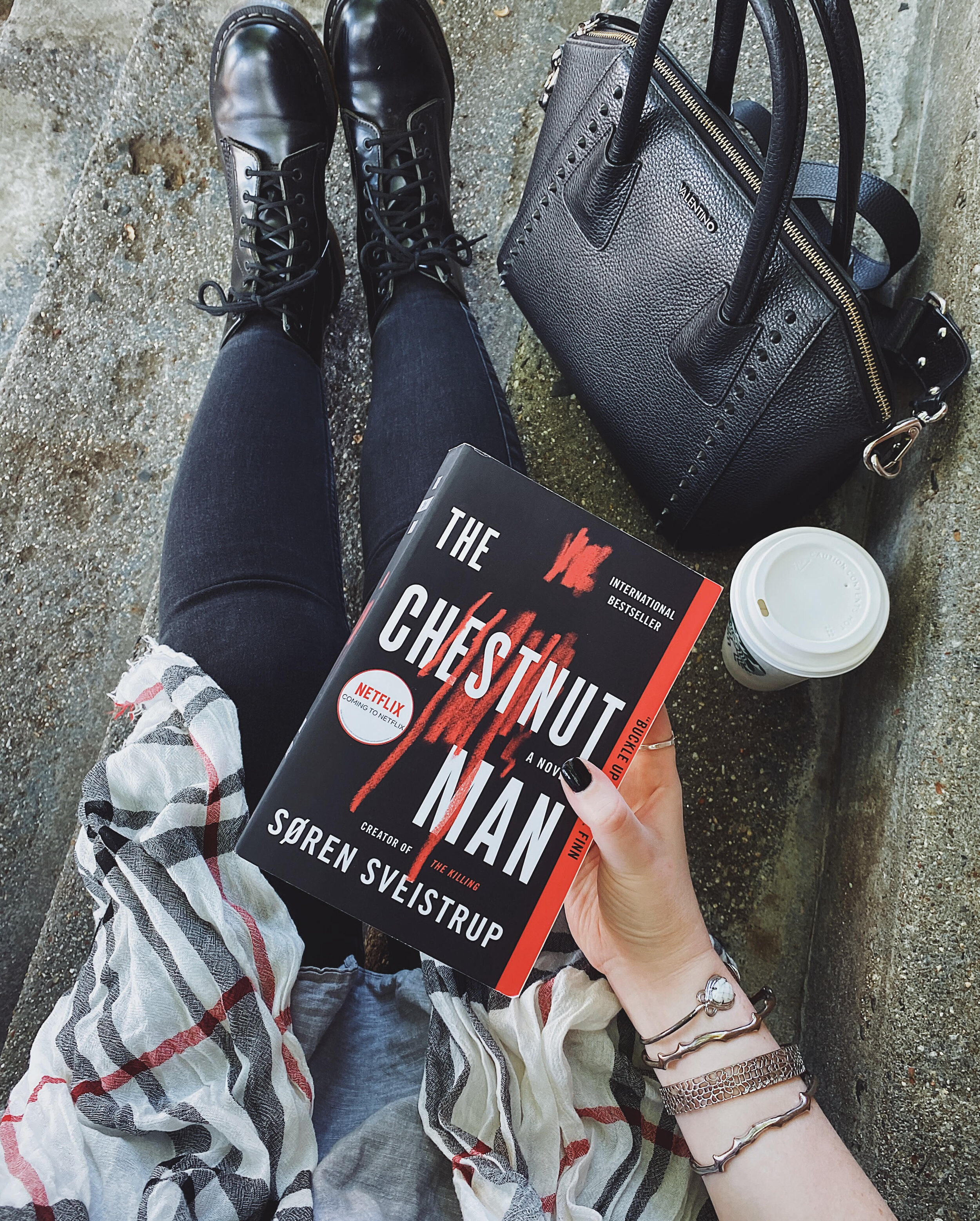Excerpt: THE CHESTNUT MAN by Søren Sveistrup
Available now in paperback
There’s nothing I love more as a reader than discovering a great new Nordic crime novel, and that’s exactly what I found last year with Søren Sveistrup’s excellent debut thriller THE CHESTNUT MAN. If you haven’t yet explored Sveistrup’s debut, you’re in luck: this outstanding Nordic serial killer thriller is available now in paperback! In THE CHESTNUT MAN, an unlikely investigative duo is on the trial of a brutal serial killer in Denmark, and this villain has a very creepy calling card: a chestnut doll (a traditional children’s craft in Denmark), which he leaves behind at each crime scene. Author Søren Sveistrup is the creator of the TV show The Killing, and his background shines through in his debut crime novel’s engaging pacing and larger-than-life protagonists and villains. Blending the immersive atmosphere of Denmark with a pacey, page-turning plot you won’t be able to put down, THE CHESTNUT MAN is an excellent Nordic thriller perfect for fans of Lars Kepler—and perfect for any reader looking for an atmospheric, chilling thriller to dig into this fall. Thanks to the publisher, I’m thrilled to be able to give CBTB readers a glimpse into THE CHESTNUT MAN today. In today’s blog post, you can revisit my full review of the book, read a Q&A with the author, and read the book’s first chapter! Read on and enter the world of THE CHESTNUT MAN.
This blog post contains Amazon Affiliate links. CBTB may earn a small commission for items purchased through these links.
About the Book:
IF YOU FIND ONE, HE’S ALREADY FOUND YOU
A psychopath is terrorizing Copenhagen.
His calling card is a “chestnut man”—a handmade doll made of matchsticks and two chestnuts—which he leaves at each bloody crime scene.
Examining the dolls, forensics makes a shocking discovery—a fingerprint belonging to a young girl, a government minister’s daughter who had been kidnapped and murdered a year ago.
A tragic coincidence—or something more twisted?
To save innocent lives, a pair of detectives must put aside their differences to piece together the Chestnut Man’s gruesome clues.
Because it’s clear that the madman is on a mission that is far from over.
And no one is safe.
From CBTB’s Review:
One of the season’s most hotly-anticipated new thrillers is finally here. From the mind that created the sensational television show The Killing now comes an equally-gripping - and equally-chilling - Nordic thriller: THE CHESTNUT MAN. In his debut crime novel, Søren Sveistrup instantly establishes himself as a must-read author for fans of Nordic Noir legends Jo Nesbø and Lars Kepler—and, for that matter, as a must-read for any reader who just wants a gripping thriller to sink their teeth into this fall. THE CHESTNUT MAN is good, old-fashioned Scandinavian crime fiction; it’s a hefty book, clocking in at 528 pages in the American hardcover edition, and immerses the reader in an intricate plot moving from the mundane details of police work to the cinematic (and gruesome) crimes of a twisted killer. If the plot of THE CHESTNUT MAN seems a bit familiar at first glance, don’t worry; Sveistrup sets up his debut novel in well-tread territory, but it quickly separates itself from the pack with richly-drawn characters, made-for-TV pacing, and, naturally, a killer with a modus operandi so sinister, you’ll want to read this book with all the lights on. The buzz surrounding the publication of THE CHESTNUT MAN has been significant; it’s earned incredible pre-publication praise, is a September Book of the Month Club selection, and is soon to be a Netflix original series. The buzz is warranted here; Sveistrup’s debut is a must-read for the crime reader looking for a big, bold, spend-all-day-reading thriller.
Read the Full Review
Q&A With Søren Sveistrup:
CBTB: One of the hallmarks of a great crime novel is a compelling and creepy villain, and The Chestnut Man has exactly that! Tell us about your story’s “bad guy.” How did you come up with the concept for this serial killer, and what made you interested in this character?
SS: In fact there’s more than one bad guy in The Chestnut Man but I know who you are referring to. When it comes to that character, I pictured my worst nightmare and tried to think of a good reason why anyone could ever behave like that. It was essential to me that the person had an understandable logic and reasoning and weren’t just behaving like a nutcase. Also, when it comes to the doings of this bad guy, I was very inspired by the way a chestnut man looks - what it consists of and how it’s put together. And finally, when you write a story about small chestnut dolls, it goes without saying that you have to have a puppet master in the story, too.
CBTB: Let’s talk about the inspiration behind your book’s title. For readers who might not be familiar with the concept, what are these chestnut men? Why were they the perfect calling card for your killer?
SS: It’s an annual tradition in Denmark: Each Autumn, when the chestnuts fall from the trees, children assemble small chestnut dolls out of chestnuts and matches and display them in windows, class rooms or the like. It’s a nice cozy children’s game. One Autumn day a few years ago I came to pick up my youngest in kindergarten and I saw the kids assembling chestnut men while they were singing a children’s song: ”Chestnut man, do come in, Chestnut man, do come in”. To me the invitation sounded creepy even though the context was so innocent. Or maybe exactly because the context was innocent. Anyway, I decided to follow my anxieties and use the small doll as a signature on a scene of crime.
Read the Full Q&A
Excerpt: THE CHESTNUT MAN
By Søren Sveistrup
Red and yellow leaves drift down through the sunlight onto the wet asphalt, which cuts through the woods like a dark and glassy river. As the white squad car tears past, they’re spun briefly in the air before coming to rest in sticky clumps along the edge of the road. Marius Larsen takes his foot off the accelerator and eases up for the bend, making a mental note to tell the council they need to come out here with the sweeper. If the leaves are left too long, they’ll make the surface slippery, and that sort of thing can cost lives. Marius has seen it many times before. He’s been on the force forty-one years, senior officer at the station for the last seventeen, and he has to prod them about it every single autumn.
But not today—today he has to focus on the conversation.
Marius fiddles irritably with the frequency on the car radio, but he can’t find what he’s looking for. Only news about Gorbachev and Reagan, and speculation about the fall of the Berlin Wall. It’s imminent, they’re saying. A whole new era may be on its way.
He’s known for a while that the conversation has to happen, yet he’s never been able to screw up his courage. Now there’s only a week until his wife thinks he’s retiring, so the time has come to tell her the truth: That he can’t cope without his job. That he’s dealt with the practical side of things and put off the decision. That he isn’t ready yet to settle on the corner sofa and watch Wheel of Fortune, to rake leaves in the garden or play Old Maid with the grandkids.
It sounds easy when he runs through the conversation in his head, but Marius knows full well she’ll be upset. She’ll feel let down. She’ll get up from the table and start scouring the stove in the kitchen, and tell him with her back turned that she under- stands. But she won’t. So when the report came over the radio ten minutes ago he told the station he’d handle it himself, postponing the conversation a little longer. Normally he’d be annoyed about having to drive all the way out to Ørum’s farm through fields and forest merely to tell them they need to keep a better eye on their animals. Several times now, pigs or cows have broken through the fence and gone roaming the neighbors’ fields until Marius or one of his men made Ørum sort it out. But today he isn’t annoyed. He asked them to call first, of course, ringing Ørum’s house and the ferry terminal, where he has a part-time job, but when nobody picked up at either place he turned off the main road and headed for the farm.
Marius finds a channel playing old Danish music. “The Bright Red Rubber Dinghy” fills the old Ford Escort, and Marius turns up the volume. He’s enjoying the autumn and the drive. The woods, their yellow, red, and brown leaves mixing with the ever- greens. The anticipation of hunting season, which is just begin- ning. He rolls down the window, the sunlight casting its dappled light onto the road through the treetops, and for a moment Marius forgets his age.
There’s silence at the farm. Marius gets out and slams the car door, and as he does so it strikes him that it’s been ages since he was last here. The wide yard looks dilapidated. There are holes in the windows of the stable, the plaster on the walls of the house is peeling off in strips, and the empty swing set on the overgrown lawn is nearly swallowed up by the tall chestnut trees encircling the property. Littered across the gravel yard are leaves and fallen chestnuts, which squelch beneath his feet as he walks up to the front door and knocks.
After Marius has knocked three times and called out Ørum’s name, he realizes nobody will answer. Seeing no sign of life, he takes out a pad, writes a note, and slips it through the mailbox, while a few crows flit across the yard and vanish behind the Fer- guson tractor parked in front of the barn. Marius has driven all the way out here on a fool’s errand, and now he’ll have to stop by the ferry terminal to get hold of Ørum. But he’s not annoyed for long: on the way back to the car, an idea pops into his head. That never usually happens to Marius, so it must be a stroke of luck that he drove out here instead of heading straight home to the conversation. Like a Band-Aid on a cut, he’ll offer his wife a trip to Berlin. They could run down there for a week—well, at least a weekend, say, as soon as he can take time off. Do the drive themselves, witness history in the making—that new era— eat dumplings and sauerkraut like they did before in Harzen, on that camping trip with the kids far too long ago. Only when he’s almost reached the car does he see why the crows are settling behind the tractor. They’re hopping around on something pallid and formless, and not until he gets closer does he realize it’s a pig. Its eyes are dead, but its body jerks and shivers as though trying to frighten off the crows, which are feeding from the gunshot wound at the back of its head.
Marius opens the front door. The hallway is dim, and he notices the scent of damp and mold, and something else he can’t quite put his finger on.
“Ørum, it’s the police.”
There’s no reply, but he can hear water running somewhere in the house, so he steps into the kitchen. The girl is a teenager. Maybe sixteen, seventeen. Her body is still sitting in the chair by the table, and what’s left of her ruined face is floating in her bowl of porridge. On the linoleum on the other side of the table is another lifeless figure. He’s a teenager too, a little older, with a gaping bul- let wound in his chest and the back of his head tilted awkwardly against the stove. Marius goes rigid. He’s seen dead people before, of course, but never anything like this, and for a brief moment he’s paralyzed, until he takes his service pistol out of the holster on his belt.
“Ørum?”
Marius proceeds farther into the house as he calls Ørum’s name, this time with his pistol raised. Still no reply. Marius finds the next corpse in the bathroom, and this time he has to clap his hand to his mouth so he doesn’t throw up. The water is running from the tap into the bathtub, which has long since filled to the brim. It’s spill- ing onto the terrazzo flooring and down the drain, intermingled with the blood. The naked woman—she must be the teenagers’ mother—is lying tangled on the floor. One arm and one leg have been separated from the torso. In the subsequent autopsy report, it will emerge that she has been struck repeatedly with an axe. First as she lay in the bathtub and then as she tried to escape by crawling onto the floor. It will also be established that she tried to defend herself with her hands and feet, which is why they have split open. Her face is unrecognizable, because the axe was used to cave in her skull.
Marius would have frozen at the sight if he hadn’t glimpsed a faint movement out of the corner of his eye. Half-hidden beneath a shower curtain dumped in the corner, he can make out a figure. Cautiously, Marius pulls back the curtain a little. It’s a boy. Dishev- eled hair, about ten or eleven. He’s lying lifeless in the blood, but a corner of the curtain is still covering the boy’s mouth, and it vibrates weakly, haltingly. Marius swiftly leans over the boy and removes the curtain, picking up his limp arm and trying to find a pulse. The boy has cuts and scratches on his arms and legs, he wears a bloody T-shirt and underwear, and an axe has been dropped near his head. Finding a pulse, Marius leaps to his feet.
In the living room he grabs feverishly at the telephone beside the full ashtray, sending it tumbling to the floor, but by the time he gets hold of the station his head is clear enough to deliver a coherent message. “Ambulance. Officers. ASAP. No trace of Ørum. Get going. Now!” When he hangs up his first thought is to hurry back to the boy, but then abruptly he remembers that there must be another child: the boy has a twin sister.
Marius heads back toward the front hall and the staircase up to the first floor. As he passes the kitchen and the open basement door, he stops short. There was a sound. A footfall or a scrape, but now there’s silence. Marius draws his pistol again. Opening the door wide, he shuffles gingerly down the narrow steps until his feet find the concrete floor. It takes his eyes a moment to adjust to the dark, and then he sees the open door at the end of the corridor. His body hesitates, telling him he ought to stop here, wait for the ambulance and his colleagues, but Marius thinks of the girl. As he approaches the door he can see it’s been forced open. The lock and bolt are discarded on the ground, and Marius enters the room, which is lit only dimly by the grime-smeared windows above. Yet he can still make out a small shape hidden well back beneath a table in the corner. Hurrying over, Marius lowers his gun, bends down, and peers underneath it.
“It’s okay. It’s over now.”
He can’t see the girl’s face, only that she’s shaking and huddled into the corner without looking at him.
“My name is Marius. I’m from the police, and I’m here to help you.”
The girl stays timidly where she is, as though she can’t even hear him, and suddenly Marius becomes aware of the room. Glancing around, he realizes what it’s been used for. He’s disgusted. Then he catches a glimpse of the crooked wooden shelves through the door to the adjoining room. The sight makes him forget the girl, and he walks across to the threshold. Marius can’t see how many there are, but there are more than he can count with the naked eye. Chestnut dolls, male and female. Animals too. Big and small, some childish, others eerie. Many of them unfinished and malformed. Marius stares at them, their number and variety, and the small dolls on the shelves fill him with disquiet, as the boy steps through the door behind him.
In a split second Marius realizes he should remember to ask Forensics whether the basement door was broken down from the inside or the outside. In a split second he realizes something monstrous may have escaped, like the animals from their pens, but when he turns toward the boy his thoughts swim away like tiny, puzzled clouds across the heavens. Then the axe strikes his jaw, and everything goes black.
Excerpt courtesy of HarperCollins.
Book Details:
Item Weight : 13.6 ounces
Paperback : 528 pages
ISBN-10 : 0062895370
ISBN-13 : 978-0062895370
Crime by the Book is a participant in the Amazon Services LLC Associates Program, an affiliate advertising program designed to provide a means for sites to earn advertising fees by advertising and linking to Amazon.com. This in no way affects my opinion of the books included in this post.













Home ownership feel like a distant dream? Zillow listings have you convinced you’ll be renting for the rest of your life? The woman at the heart of Carissa Orlando’s debut The September House feels your pain—and she’s prepared to put up with a lot if it means she and her husband can finally have a place to call their own. In this case, that might just mean living in a house that’s haunted. Playful and irreverent, spine-tingling and spooky, The September House puts a fresh spin on the classic haunted house story, delivering an immersive tale about the secrets lurking within one building’s walls, and within the lives of its inhabitants.